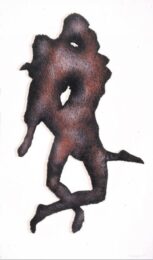


Born in 1923, American painter and sculptor Richard Artschwager had a reputation for being a creative individualist. His work has associations with Pop Art, Conceptual art and Minimalism. In 1941, he began studying at Cornell University. His studies were interrupted by military service in World War 2, when he was sent to England to fight. After the war, he resumed his studies and graduated with a B.A. in Physics in 1948.
Despite his scientific education, Artschwager had a passion for art and subsequently pursued a career as an artist. He studied art in Paris at the end of the 1940s under the French cubist painter Amédée Ozenfant. He made simple furniture and built a business as a designer to support his family, successfully mixing his creative expression with the practical skills of a craftsman. In 1960 Artschwager was commissioned by the Catholic Church to make portable altars for ships, and it was this work that influenced him to impose his artistic expression on utilitarian objects such as tables and chairs. He worked in a variety of materials, Celotex, Formica, and wood.
Richard Artschwager is also noted for his architectural work, which explores the processes of fragmentation and expansion. One of his most famous pieces is Table With Pink Tablecloth, a work in three-dimensions constructed of Formica on wood. It has been described as something of a cross between Pop Art and a Minimalist cube.